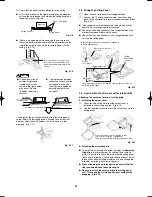
36
(5) Use shielded wires for inter-unit control wiring (c) and
ground the shield on one side, otherwise misoperation
from noise may occur. (Fig. 5-6)
Connect wiring as shown in Section “5-3. Wiring System
Diagrams”.
Shielded wire
Ground
Fig. 5-6
WARNING
Loose wiring may cause the terminal to overheat or result
in unit malfunction. A fire hazard may also occur. Therefore,
ensure that all wiring is tightly connected.
When connecting each power wire to the terminal, follow the
instructions on “How to connect wiring to the terminal” and
fasten the wire securely with the terminal screw.
How to connect wiring to the terminal
■
For stranded wires
(1) Cut the wire end with cutting pliers, then strip the insulation
to expose the stranded wire about 10 mm and tightly twist
the wire ends. (Fig. 5-7)
Stranded wire
Strip 10 mm
Ring
pressure
terminal
Fig. 5-7
(2) Using a Phillips head screwdriver, remove the terminal
screw(s) on the terminal plate.
(3) Using a ring connector fastener or pliers, securely clamp
each stripped wire end with a ring pressure terminal.
(4) Put the removed terminal screw through the ring pressure
terminal and then replace and tighten the terminal screw
using a screwdriver. (Fig. 5-8)
Ring
pressure
terminal
Special
washer
Screw
Terminal plate
Ring pressure
terminal
Wire
Wire
Screw and
Special washer
Fig. 5-8
6. HOW TO INSTALL THE TIMER REMOTE
CONTROLLER (OPTIONAL PART)
NOTE
Refer to the Instruction Manual attached to the optional Timer
Remote Control Unit.
7. HOW
TO
PROCESS
TUBING
The liquid tubing side is connected by a flare nut, and the gas
tubing side is connected by brazing.
7-1. Connecting the Refrigerant Tubing
Use of the Flaring Method
Many of conventional split system air conditioners employ the
flaring method to connect refrigerant tubes that run between
indoor and outdoor units. In this method, the copper tubes are
flared at each end and connected with flare nuts.
Flaring Procedure with a Flare Tool
(1) Cut the copper tube to the required length with a tube
cutter. It is recommended to cut approx. 30 – 50 cm longer
than the tubing length you estimate.
(2) Remove burrs at each end of the copper tubing with a
tube reamer or file. This process is important and should
be done carefully to make a good flare. Be sure to keep
any contaminants (moisture, dirt, metal filings, etc.) from
entering the tubing. (Figs. 7-1 and 7-2)
After
Before
Deburring
Copper
tubing
Reamer
Fig. 7-1
Fig. 7-2
NOTE
When reaming, hold the tube end downward and be sure that
no copper scraps fall into the tube. (Fig. 7-2)
(3) Remove the flare nut from the unit and be sure to mount it
on the copper tube.
(4) Make a flare at the end of the copper tube with a flare tool.
(Fig. 7-3)
Flare nut
Copper
tubing
Flare tool
Fig. 7-3
NOTE
A good flare should have the following characteristics:
●
inside surface is glossy and smooth
●
edge is smooth
●
tapered sides are of uniform length
Flare size: A (mm)
A
Copper tubing
(Outer dia.)
A
0
– 0.4
ø6.35
9.1
ø9.52
13.2
ø12.7
16.6
ø15.88
19.7
Airwell̲PAC-i̲eng.indb 36
Airwell̲PAC-i̲eng.indb 36
2009/07/09 16:13:29
2009/07/09 16:13:29
Содержание OU-PSINV-25HR
Страница 75: ...75 ...
















































